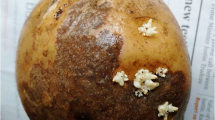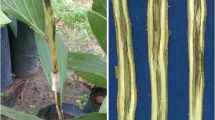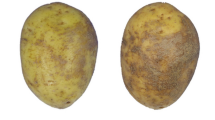Abstract
Silver scurf, caused by Helminthosporium solani, and black dot, caused by Colletotrichum coccodes, cause tuber blemishes on potato (Solanum tuberosum L.) which affect processing and fresh market trade. Tubers from ten cultivars were collected at harvest from three organic farms in Wisconsin and categorized as symptomatic or asymptomatic based on visual symptoms of silver scurf and black dot and/or signs of H. solani and C. coccodes. Tuber incubation and PCR assays were performed on asymptomatic tubers to detect H. solani and C. coccodes. Tuber incubation and PCR assays were in slight to fair agreement (kappa coefficient <0.4) for detecting both pathogens. Most asymptomatic tubers tested were positive by one or both assays for H. solani (75 %) or C. coccodes (94 %). Minituber inoculation assays were also performed to screen potato lines for resistance to silver scurf. Of the 14 lines tested, a diploid interspecific hybrid, C287, had consistently low sporulation, suggesting it has partial resistance to silver scurf. Since the majority of tubers harvested are already infected with one or both pathogens further research should focus on organically acceptable management practices that may inhibit disease development in field and in storage.
Resumen
La mancha plateada, causada por Helminthosporium solani y la mancha negra, por Colletotrichum coccodes, originan manchas en los tubérculos de papa (Solanum tuberosum L.), que afectan el intercambio de mercado de procesamiento y en fresco. Se colectaron tubérculos de diez variedades a la cosecha de tres unidades de producción orgánica en Wisconsin, y se clasificaron como sintomáticas y asintomáticas con base en síntomas visuales de mancha plateada o negra y/o con señales de H. solani y C. coccodes. Se condujeron incubaciones de tubérculo y ensayos de PCR en tubérculos asintomáticos para la detección de H. solani y C. coccodes. La incubación de los tubérculos y los ensayos de PCR coincidieron de ligera a consistentemente (coeficiente de Kappa <0.4) en la detección de ambos patógenos. La mayoría de los tubérculos asintomáticos probados fueron positivos por uno o ambos ensayos para H. solani (75 %) o C. coccodes (94 %). También se efectuaron ensayos de inoculación en minitubérculos para seleccionar líneas de papa para la resistencia de la mancha plateada. De las 14 líneas probadas, un híbrido interespecífico diploide, C287, tuvo baja esporulación consistentemente, sugiriendo que tiene resistencia parcial a la mancha plateada. Considerando que la mayoría de los tubérculos cosechados ya están infectados con uno o ambos patógenos, la investigación futura se podría enfocar en prácticas de manejo orgánicamente aceptables que pudieran inhibir el desarrollo de la enfermedad en el campo y en el almacén.


Similar content being viewed by others
References
Burke, O.D. 1938. The silver scurf disease of potatoes. Bulletin of Cornell University Agricultural Experimental Station 692: 1–30.
CIP (International Potato Center). Potatoes: facts and figures. http://cipotato.org/ potato/facts. Accessed 14 December 2012.
Cohen, J. 1960. A coefficient of agreement for nominal scales. Educational and Psychological Measurement 20: 37–46.
Cullen, D.W., A.K. Lees, I.K. Toth, and J.M. Duncan. 2001. Conventional PCR and real-time quantitative PCR detection of Helminthosporium solani in soil and on potato tubers. European Journal of Plant Pathology 107: 387–398.
Cullen, D.W., A.K. Lees, I.K. Toth, and J.M. Duncan. 2002. Detection of Colletotrichum coccodes from soil and potato tubers by conventional and quantitative real-time PCR. Plant Pathology 51: 281–292.
Davis, J.R., and D.A. Johnson. 2001. Black dot. In Compendium of potato diseases, ed. W.R. Stevenson, R. Loria, G.D. Franc, and D.P. Weingartner, 14–16. St. Paul: American Phytopathological Society Press.
Errampalli, D., J.M. Saunders, and J.D. Holley. 2001. Emergence of silver scurf (Helminthosporium solani) as an economically important disease of potato. Plant Pathology 50: 141–153.
Frost, K.F., S.H. Jansky, and D.I. Rouse. 2006. Transmission of Verticillium wilt resistance to tetraploid potato via unilateral sexual polyploidization. Euphytica 149: 281–287.
Geary, B., and D.A. Johnson. 2006. Relationship between silver scurf levels on seed and progeny tubers from successive generations of potato seed. American Journal of Potato Research 83: 447–453.
Geary, B., D.A. Johnson, P.B. Hamm, S. James, and K.A. Rykbost. 2007. Potato silver scurf affected by tuber seed treatments and locations, and occurrence of fungicide resistant isolates of Helminthosporium solani. Plant Disease 91: 315–320.
Glais, I., and D. Andrivon. 2004. Deep sunken lesions – an atypical symptom on potato tubers caused by Colletotrichum coccodes during storage. Plant Pathology 53: 254.
Glais-Varlet, I., K. Bouchek-Mechiche, and D. Andrivon. 2004. Growth in vitro and infectivity of Colletotrichum coccodes on potato tubers at different temperatures. Plant Pathology 53: 398–404.
Goth, R.W., and R.E. Webb. 1983. Maintenance and growth of Helminthosporium solani. American Potato Journal 60: 281–287.
Greenway, G.A., J.F. Guenthner, L.D. Makus, and M.J. Pavek. 2011. An analysis of organic potato demand in the U.S. American Journal of Potato Research 88: 184–189.
Hunger, R.M., and G.A. McIntyre. 1979. Occurrence, development, and losses associated with silver scurf and black dot on Colorado potatoes. American Potato Journal 56: 289–306.
Jansky, S.H., and D.I. Rouse. 2003. Multiple disease resistance in interspecific hybrids of potato. Plant Disease 87: 266–272.
Jellis, G.J., and G.S. Taylor. 1974. The relative importance of silver scurf and black dot: Two disfiguring diseases of potato tubers. ADAS Quarterly Review 14: 53–61.
Jellis, G.J., and G.S. Taylor. 1977. The development of silver scurf (Helminthosporium solani) disease of potato. Annals of Applied Biology 86: 19–28.
Johnson, D.A., and E.R. Miliczky. 1993. Effects of wounding and wetting duration on infection of potato foliage by Colletotrichum coccodes. Plant Disease 77: 13–17.
Johnson, D.A., R.C. Rowe, and T.F. Cummings. 1997. Incidence of Colletotrichum coccodes in certified potato seed tubers planted in Washington state. Plant Disease 81: 1199–1202.
Landis, J.R., and G.G. Koch. 1977. The measurement of observer agreement for categorical data. Biometrics 33: 159–174.
Lees, A.K., and A.J. Hilton. 2003. Black dot (Colletotrichum coccodes): an increasingly important disease of potato. Plant Pathology 52: 3–12.
Mawson, K. 1999. Drying for disease control in store. In Interim project report for the British Potato Council, 1–17. Oxford: British Potato Council.
Merida, C.L., and R. Loria. 1994. Survival of Helminthosporium solani in soil and in vitro colonization of senescent plant tissue. American Potato Journal 71: 591–598.
Merida, C.L., R. Loria, and D.E. Halseth. 1994. Effects of potato cultivar and time of harvest on the severity of silver scurf. Plant Disease 78: 146–149.
Munck, I.A., and G.R. Stanosz. 2009. Quantification of conidia of Diplodia spp. extracted from red and jack pine cones. Plant Disease 93: 81–86.
Murphy, A.M., H.D. Jong, and G.C.C. Tai. 1995. Transmission of resistance to common scab from the diploid to the tetraploid level via 4x × 2x crosses in potatoes. Euphytica 82: 227–233.
Nitzan, N., P. Hamm, D. Johnson, J. Miller, and N. David. 2005. Bumpy tuber- a post harvest disease on potato associated with the black dot fungus. Washington State Potato Progress 5(15): 1–6. Washington State Potato Commission. (Online) www.potatoes.com.
Rodriguez, D.A., G.A. Secor, N.C. Gudmestad, and K. Grafton. 1995. Screening tuber-bearing Solanum species for resistance to Helminthosporium solani. American Potato Journal 72: 669–679.
Rodriguez, D.A., G.A. Secor, N.C. Gudmestad, and L.J. Francl. 1996. Sporulation of Helminthosporium solani and infection of potato tubers in seed and commercial storages. Plant Disease 80: 1063–1070.
Secor, G.A. 1994. Management strategies for fungal diseases of tubers. In Advances in potato pest biology and management, ed. G.W. Zhender, M.L. Powelson, R.K. Jansson, and K.V. Raman, 155–157. St.Paul: American Phytopathological Society Press.
Stevens-Garmon, J., C.L. Huang, and B.-H. Lin. 2007. Organic demand: A profile of consumers in the fresh produce market. Choices 22: 109–115.
Thomas, J.E., P.T. Gans, and D.M. Kenyon. 2005. Resistance to disease in commercial potato cultivars and its use in disease management. Aspects of Applied Biology 76: 121–126.
Tsror, L., M. Aharon, and O. Erlich. 1999. Survey of bacterial and fungal seedborne diseases in imported and domestic potato seed tubes. Phytoparasitica 27: 215–226.
Acknowledgements
We thank Nicholas Keuler for help with statistical analyses and Samantha Sparrow for performing the minituber inoculation assays. We thank Dr. Douglas Rouse for help with discussion, and organic potato growers: Brad, Brian and Tom Igl, Chris Malek and George Kohn for their assistance. This work was funded by the Graduate Student Research grant from the Ceres Trust and the USDA-OREI grant 2009-51300-05582.
All the experiments performed complied with the current regulations of the United States of America.
Author information
Authors and Affiliations
Corresponding author
Electronic Supplementary Material
Below is the link to the electronic supplementary material.
Supplementary Fig. 1
Conidia and Conidiophores of Helminthosporium solani (left side) and sclerotia of Colletotrichum coccodes (right side) observed in close proximity on a potato tuber periderm under a dissecting microscope (JPEG 47 kb)
ESM 1
(TIFF 1773 kb)
Rights and permissions
About this article
Cite this article
Mattupalli, C., Genger, R.K. & Charkowski, A.O. Evaluating Incidence of Helminthosporium solani and Colletotrichum coccodes on Asymptomatic Organic Potatoes and Screening Potato Lines for Resistance to Silver Scurf. Am. J. Potato Res. 90, 369–377 (2013). https://doi.org/10.1007/s12230-013-9314-3
Published:
Issue Date:
DOI: https://doi.org/10.1007/s12230-013-9314-3




